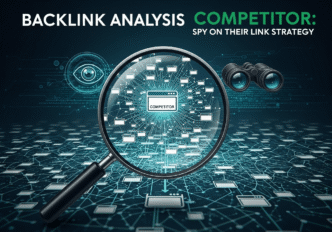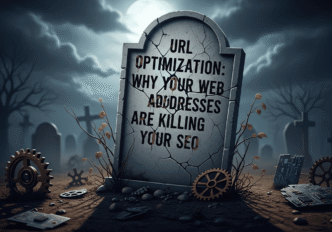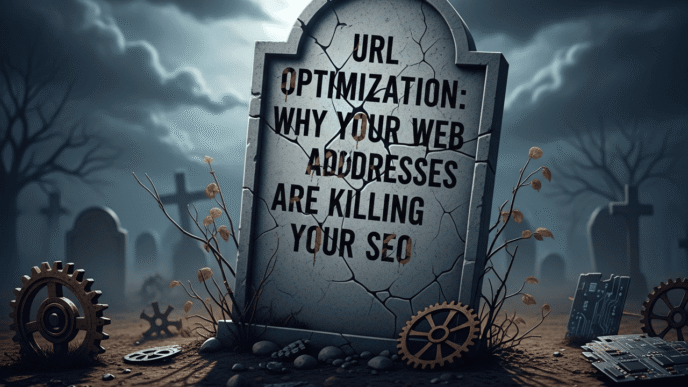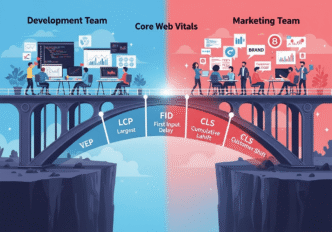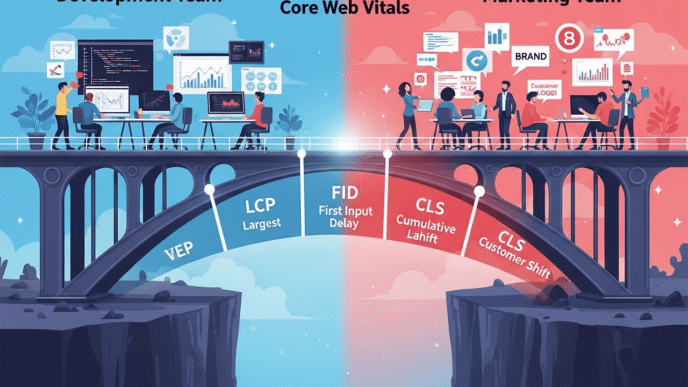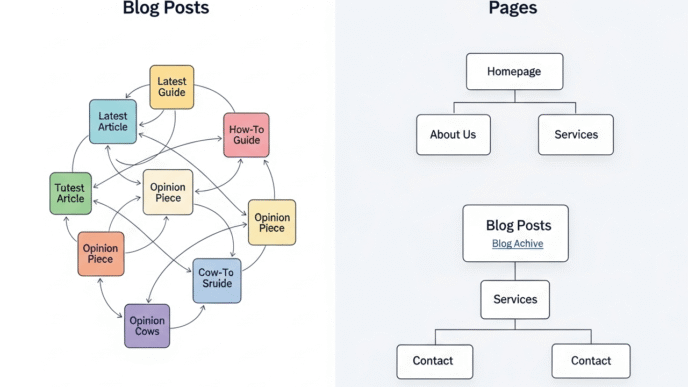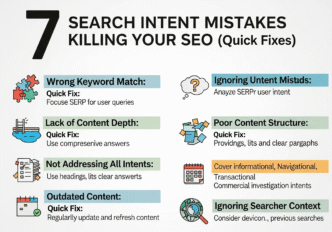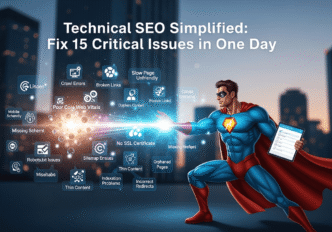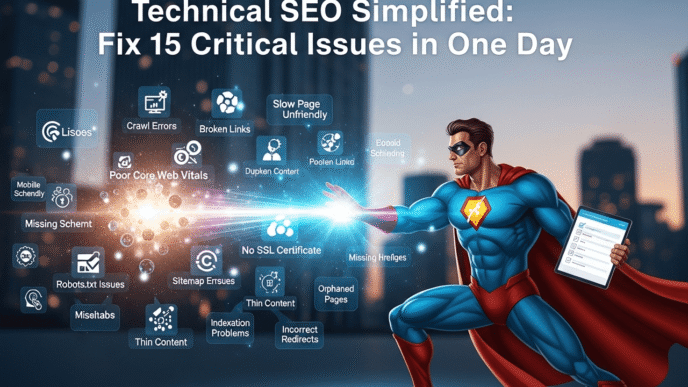Your competitor just leapfrogged you in the search rankings again, and you’re sitting there wondering if they’ve discovered some secret SEO sauce or hired a digital marketing wizard. Plot twist: they probably just got really good at backlink analysis competitor research while you were busy creating “amazing content” that nobody’s linking to.
Here’s the uncomfortable truth: your competitors aren’t necessarily smarter than you – they’re just better spies. While you’ve been playing fair and hoping for the best, they’ve been systematically analyzing what works, stealing the best strategies, and leaving you in their digital dust.
Competitor research isn’t cheating – it’s intelligence gathering. It’s like studying your opponent’s playbook before the big game, except in SEO, the playbook is completely visible if you know where to look. The best part? You can legally and ethically spy on competitor SEO backlink strategy using tools and techniques that reveal exactly how they’re dominating search results.
Ready to transform from SEO victim to SEO detective? Let’s dive into the art of competitive intelligence that’ll have you uncovering your competitors’ link building secrets faster than they can say “proprietary strategy.”
Table of Contents
ToggleWhy Is Backlink Analysis Competitor Research So Powerful?
Backlink analysis competitor research is like having x-ray vision for SEO strategy. Instead of guessing what might work, you’re seeing exactly what IS working for businesses in your space.
Your competitors have already done the hard work of testing different link opportunities, building relationships, and figuring out which strategies deliver results. By analyzing their successes (and failures), you’re essentially getting a PhD in link building without the tuition fees.
Competitive intelligence reveals patterns you’d never discover on your own. Maybe all your top competitors are getting links from a specific industry publication you’ve never heard of. Or perhaps there’s a broken link building opportunity they all missed that you can capitalize on.
Understanding what backlinks are and why they matter provides the foundation for appreciating why competitor link profiles analysis can fast-track your own link building success.
The beautiful truth about competitive analysis? Your competitors are inadvertently doing market research for you, identifying which tactics work in your specific industry and target market.
How to Analyze Competitor Backlinks for Free: Getting Started Without Breaking the Bank
Competitor SEO analysis doesn’t require a Fortune 500 budget. Several powerful free tools can give you valuable insights into competitor link building opportunities and strategies without spending a dime.
Free Competitive Analysis Arsenal:
- Google Search Operators: Uncover competitor mentions and link opportunities
- Ubersuggest Free Version: Basic competitor backlink overview
- Google Search Console: Analyze your own links vs. competitor performance
- Wayback Machine: Historical competitor content and link analysis
- Social Media: Track competitor partnerships and relationship building
Google Search Operators for Competitive Intelligence
Advanced Search Techniques:
site:competitor.com -site:competitor.com "your target keyword"
"competitor name" -site:competitor.com
"competitor CEO name" interview OR podcast
"competitor name" guest post OR "contributed by"
"competitor name" partnership OR collaboration
Link Opportunity Discovery:
"your keyword" + resources -site:yoursite.com -site:competitor.com
"your industry" + directory -site:yoursite.com
"your keyword" + "write for us" -site:competitor.com
"your niche" + guest post guidelines
These searches reveal where competitors are getting coverage and identify untapped opportunities they might have missed.
Pro Tip: “Start with free tools to understand the competitive landscape, then invest in premium tools only after you’ve identified specific competitors and strategies worth analyzing deeper.”
Find Competitor Link Building Opportunities: Premium Tool Strategies
Reverse engineer competitor backlink profiles effectively requires premium tools that provide comprehensive data and advanced filtering capabilities.
Premium Competitive Analysis Tools Comparison
| Tool | Monthly Cost | Database Size | Competitor Features | Best For |
|---|---|---|---|---|
| Ahrefs | $99-$999 | 22+ billion pages | Link intersect, content gap | Comprehensive analysis |
| SEMrush | $119-$449 | 20+ billion pages | Backlink gap, position tracking | All-in-one campaigns |
| Moz Pro | $99-$599 | 40+ billion links | Link intersect, competitive research | Beginner-friendly analysis |
| Majestic | $49-$399 | 7+ billion pages | Trust flow, citation flow | Link quality focus |
| SpyFu | $39-$299 | Keyword-focused | Competitor ad/organic overlap | Budget-conscious research |
Ahrefs: The Competitor Analysis Powerhouse
Ahrefs Competitive Features:
- Site Explorer: Complete competitor backlink profile analysis
- Link Intersect: Find sites linking to competitors but not you
- Content Gap: Identify keywords competitors rank for but you don’t
- Backlink Gap: Discover link opportunities competitors are getting
Step-by-Step Ahrefs Competitor Analysis:
- Enter competitor domain in Site Explorer
- Analyze referring domains and identify highest-authority link sources
- Use Link Intersect to find sites linking to multiple competitors
- Export opportunity lists and categorize by acquisition difficulty
- Track competitor growth over time to identify successful strategies
SEMrush: Integrated Competitive Intelligence
SEMrush Advantage Areas:
- Backlink Analytics: Comprehensive competitor link analysis
- Keyword Gap: Find competitor ranking opportunities
- Brand Monitoring: Track competitor mentions and coverage
- Position Tracking: Monitor competitor ranking changes over time
SEMrush Competitive Workflow:
- Set up competitor tracking in Backlink Analytics
- Run Backlink Gap analysis to identify missing link opportunities
- Use Link Building Tool to find prospects linking to competitors
- Monitor competitor campaigns through regular analysis updates
- Track success metrics comparing your growth to competitor performance
Competitor Link Profiles Deep Dive: What to Look For
Backlink espionage requires understanding what makes competitor link profiles effective and how to identify their most valuable link sources.
Link Profile Analysis Framework
Authority Distribution Analysis:
- Top 10% of links: What are their highest-authority link sources?
- Industry-specific links: Which niche publications consistently link to them?
- Geographic links: Are they dominating local or regional link sources?
- Content type patterns: What content formats earn their best links?
Link Acquisition Timeline:
- Growth velocity: How quickly are they acquiring new links?
- Seasonal patterns: Do they have specific campaign periods?
- Campaign spikes: Can you identify specific outreach campaigns?
- Relationship building: Are links coming from ongoing partnerships?
Competitive Link Quality Assessment
High-Value Link Identification:
- Editorial placement: Links within article content vs. sidebars/footers
- Relevance matching: Industry alignment and topical authority
- Traffic potential: Link sources with active, engaged audiences
- Relationship depth: Evidence of ongoing partnerships vs. one-off mentions
Red Flag Detection:
- Paid link networks: Suspicious patterns across multiple sites
- Low-quality directories: Mass directory submissions
- Reciprocal linking schemes: Mutual back-and-forth linking patterns
- Private blog networks: Links from related or similar sites
Pro Tip: “Focus on analyzing your competitors’ newest and highest-authority links first. These reveal their current strategies and most valuable relationship sources.”
Link Gap Analysis: Finding Untapped Opportunities
Competitor link gap analysis tools and techniques help identify link sources that benefit your competitors but aren’t linking to you yet.
The Link Intersect Strategy
Multi-Competitor Analysis Process:
- Identify 3-5 top competitors in your space
- Run link intersect analysis to find common link sources
- Prioritize opportunities by authority and relevance
- Analyze linking content to understand why they earned links
- Develop targeted outreach strategy for each opportunity
Link Opportunity Scoring:
- Authority weight (40%): Domain authority and page authority scores
- Relevance factor (30%): Topical alignment and audience overlap
- Achievability (20%): Likelihood of successful outreach
- Traffic potential (10%): Estimated referral traffic value
Content Gap Link Opportunities
Content-Based Competitive Analysis:
- Topic coverage gaps: What content topics are competitors covering that you’re not?
- Format opportunities: Are competitors succeeding with specific content formats?
- Resource creation: What types of linkable assets are competitors developing?
- Update opportunities: Can you create better, more current versions of linked content?
Gap Analysis Implementation:
- Export competitor’s most-linked content from analysis tools
- Categorize content types and topic areas
- Identify content gaps in your own coverage
- Plan superior content that deserves more links than competitor versions
- Target original linkers with improved resource suggestions
Reverse Engineer Competitor Backlink Profiles: Strategic Deconstruction
Reverse engineering successful competitor strategies requires systematic analysis of their link building approaches and relationship patterns.
Strategy Pattern Recognition
Link Building Tactic Identification:
- Guest posting patterns: Regular contributors to specific publications
- Resource page inclusions: Systematic targeting of industry resource lists
- Broken link building: Evidence of broken link replacement campaigns
- Partnership announcements: Joint ventures and collaboration coverage
- PR and media outreach: Press release and news coverage patterns
Relationship Mapping:
- Recurring link sources: Sites that link to competitors multiple times
- Timeline correlation: Links appearing around same time periods
- Cross-referencing: Sites linking to multiple competitors
- Author relationships: Personal connections driving link opportunities
Campaign Reverse Engineering
Identifying Specific Campaigns:
- Link cluster analysis: Groups of links acquired within short timeframes
- Anchor text patterns: Coordinated anchor text strategies
- Content promotion spikes: Social and link activity around content launches
- Event-based linking: Links tied to specific industry events or announcements
Case Study: SaaS Competitor Analysis Success
Background: B2B software company struggling to compete with established player in project management space.
Competitive Analysis Process:
- Identified top 3 competitors using Ahrefs and SEMrush
- Analyzed 2,847 competitor backlinks across 12-month period
- Mapped 67 unique link sources not currently linking to client
- Reverse engineered content strategies from most successful competitor campaigns
Key Discoveries:
- HR industry publications were underutilized link source (34 opportunities)
- Productivity blog network had systematic guest posting program
- Industry conference partnerships generated 15+ high-authority links annually
- Tool integration announcements consistently earned coverage
Implementation Results:
- 89 new backlinks acquired within 6 months using competitor insights
- Average domain authority: 52 (compared to previous average of 31)
- Organic traffic increase: 247% over campaign period
- Target keyword rankings: 12 first-page improvements
Replicable Success Factors:
- Systematic competitor identification and analysis
- Focus on link sources with proven industry relevance
- Content strategy informed by competitor success patterns
- Relationship building based on competitor partnership models
Competitive Intelligence Automation and Monitoring
Spy on competitor SEO backlink strategy systematically through automated monitoring and alert systems that catch new opportunities as they develop.
Automated Competitor Monitoring Setup
Alert System Configuration:
- New backlink alerts: Notifications when competitors gain new links
- Content mention tracking: Alerts for competitor coverage and partnerships
- Keyword ranking changes: Monitor competitor SERP movements
- Social media monitoring: Track competitor relationship building activities
Monitoring Tools Integration:
- Google Alerts: Free monitoring for competitor mentions and news
- Mention.com: Comprehensive brand and competitor tracking
- Ahrefs Alerts: Automated competitor backlink monitoring
- SEMrush Brand Monitoring: Competitor activity and mention tracking
Competitive Data Organization
Analysis Dashboard Creation:
- Competitor link profiles: Monthly snapshots of growth and changes
- Opportunity pipeline: Prioritized list of target link sources
- Campaign tracking: Monitor your progress against competitor benchmarks
- Relationship mapping: Visual representation of competitor link networks
Regular Review Schedule:
- Weekly monitoring: Check for new competitor links and opportunities
- Monthly deep dives: Comprehensive analysis of competitor strategy changes
- Quarterly strategy reviews: Adjust approach based on competitive landscape shifts
- Annual competitive audits: Complete reassessment of competitive positioning
Advanced Competitor Research Techniques
Competitor SEO analysis can be enhanced through sophisticated techniques that reveal deeper strategic insights and hidden opportunities.
Historical Competitor Analysis
Wayback Machine Strategy:
- Content evolution tracking: How competitor content has changed over time
- Link building timeline: Historical view of when specific links were acquired
- Strategy shift identification: Changes in competitor approach and focus
- Seasonal pattern analysis: Recurring campaign timing and themes
Long-term Trend Analysis:
- Growth velocity comparison: Rate of competitor link acquisition over time
- Authority progression: How competitors built domain authority systematically
- Content format evolution: Changes in linkable asset creation strategies
- Relationship development: Long-term partnership and collaboration patterns
Cross-Channel Competitive Intelligence
Social Media Link Building Analysis:
- Partnership announcements: Social media reveals collaboration opportunities
- Content promotion patterns: How competitors amplify their content
- Influencer relationships: Key personalities in competitor networks
- Event participation: Speaking and sponsorship opportunities competitors pursue
Email Marketing Intelligence:
- Newsletter partnerships: Cross-promotional opportunities and guest features
- Content syndication: How competitors distribute content for links
- Industry digest inclusion: Regular features in industry communications
- Expert roundup participation: Systematic inclusion in expert content
Link Opportunities Prioritization and Execution
Find competitor link building opportunities systematically requires frameworks for prioritizing prospects and executing outreach campaigns efficiently.
Opportunity Scoring Framework
Multi-Factor Assessment Matrix:
| Factor | Weight | High Score (3) | Medium Score (2) | Low Score (1) |
|---|---|---|---|---|
| Domain Authority | 25% | 60+ DA | 30-59 DA | Under 30 DA |
| Industry Relevance | 25% | Highly relevant | Somewhat relevant | Minimally relevant |
| Competitor Success | 20% | Multiple competitors linked | 1-2 competitors linked | Limited evidence |
| Outreach Difficulty | 15% | Accessible contact info | Some research needed | Difficult to reach |
| Traffic Potential | 15% | High engagement | Moderate engagement | Low engagement |
Systematic Outreach Campaign Development
Campaign Structure:
- Tier 1 Opportunities: Highest-scoring prospects requiring personalized outreach
- Tier 2 Prospects: Medium-scoring opportunities suitable for template-based outreach
- Tier 3 Targets: Lower-priority prospects for automated or scaled campaigns
- Relationship Building: Long-term prospects requiring multiple touchpoints
Outreach Message Framework:
- Competitor connection mention: Reference their existing coverage of competitors
- Value proposition: Explain why your content/business deserves similar coverage
- Specific request: Clear, actionable next steps for the recipient
- Relationship building: Focus on long-term value rather than one-off links
Competitor Link Gap Analysis Tools: Advanced Implementation
Competitor link gap analysis tools and techniques provide systematic approaches for identifying and capitalizing on competitive advantages.
Advanced Gap Analysis Workflows
Multi-Tool Integration Strategy:
- Ahrefs for comprehensive data: Complete competitor backlink profiles
- SEMrush for gap identification: Systematic opportunity discovery
- Moz for quality assessment: Link authority and spam risk evaluation
- Manual verification: Confirm tool data with human analysis
Gap Analysis Execution Process:
- Export competitor backlink data from multiple sources
- Cross-reference with your current profile to identify true gaps
- Categorize opportunities by acquisition method and difficulty
- Research link context to understand why competitors earned links
- Develop targeted content and outreach strategies for each category
Competitive Advantage Identification
Unique Opportunity Discovery:
- Untapped sources: Link opportunities competitors have missed
- Content format gaps: Types of content competitors aren’t creating
- Geographic opportunities: Regional sources competitors aren’t targeting
- Industry segment gaps: Niche areas within your market
First-Mover Advantage Strategies:
- Emerging publication relationships: New industry publications and blogs
- Technology trend coverage: Early adoption of industry trends and innovations
- Event sponsorship opportunities: New conferences and industry gatherings
- Partnership potential: Collaboration opportunities competitors haven’t pursued
Pro Tip: “The best competitive opportunities are often the ones your competitors can’t or won’t pursue. Look for gaps that align with your unique strengths or market position.”
Measuring Competitive Intelligence ROI and Success
Backlink analysis competitor research investment requires systematic measurement to optimize strategy and demonstrate value.
Competitive Analysis KPIs
Discovery Metrics:
- Opportunity identification rate: New prospects discovered per analysis hour
- Quality opportunity percentage: High-value prospects vs. total opportunities found
- Competitive coverage: Percentage of competitor strategies analyzed and understood
- Gap exploitation rate: Successful acquisition of competitor-identified opportunities
Implementation Success:
- Link acquisition rate: Percentage of identified opportunities successfully converted
- Authority improvement: Domain authority gains relative to competitive benchmarks
- Ranking improvements: Keyword position gains in competitive search results
- Traffic growth: Organic traffic increases compared to competitor performance
Long-term Competitive Advantage Building
Strategic Positioning Metrics:
- Market share growth: Relative improvement in search visibility vs. competitors
- Link velocity comparison: Rate of link acquisition compared to competitive average
- Authority gap closure: Reduction in domain authority differences with top competitors
- Unique advantage development: Link sources exclusive to your business
Relationship Building Success:
- Exclusive partnerships: Relationships competitors don’t have access to
- Thought leadership recognition: Industry authority building relative to competitors
- Content performance: Link-earning content outperforming competitor equivalent
- Network effect creation: Referrals and introductions from acquired relationships
Understanding the fundamental importance of backlinks helps contextualize why competitive intelligence provides such powerful advantages in link building strategy.
Future-Proofing Competitor Analysis: Emerging Trends and Technologies
Competitive intelligence continues evolving with advances in AI, automation, and data analysis capabilities.
AI-Powered Competitive Analysis
Machine Learning Applications:
- Pattern recognition: AI identification of successful competitor strategies
- Predictive analysis: Forecasting competitor link building opportunities
- Content optimization: AI-driven content creation based on competitor success patterns
- Relationship mapping: Advanced network analysis and relationship identification
Automation Advancement:
- Real-time monitoring: Instant alerts for competitor activity and opportunities
- Automated research: AI-powered prospect identification and qualification
- Dynamic strategy adjustment: Algorithm-based campaign optimization
- Performance prediction: Machine learning models for opportunity success probability
Privacy and Data Access Evolution
Adapting to Data Restrictions:
- First-party data focus: Increased reliance on owned data and direct relationships
- Social media intelligence: Enhanced social listening for competitive insights
- Public information analysis: Sophisticated analysis of publicly available data
- Relationship-based intelligence: Human network development for competitive insights
Sustainable Competitive Advantage:
- Unique value creation: Developing advantages competitors can’t easily replicate
- Network effect building: Creating self-reinforcing competitive positions
- Innovation leadership: Staying ahead of competitive analysis and strategy
- Ethical intelligence gathering: Maintaining integrity while maximizing insight value
Your Backlink Analysis Competitor Action Plan
Week 1-2: Competitive Landscape Mapping
Initial Competitor Identification:
- Research and identify 5-10 direct competitors using keyword overlap analysis
- Set up basic monitoring for competitor mentions and backlink activity
- Choose primary analysis tools based on budget and feature requirements
- Create competitor tracking spreadsheet with key metrics and contact information
Baseline Analysis:
- Export competitor backlink profiles using chosen analysis tools
- Identify top 20 highest-authority link sources for each competitor
- Create initial opportunity pipeline with basic categorization
- Document current competitive positioning and authority gaps
Week 3-4: Deep Analysis and Strategy Development
Comprehensive Competitor Research:
- Perform detailed link intersect analysis across multiple competitors
- Identify content types and strategies driving competitor link success
- Research relationship patterns and partnership opportunities
- Develop target prospect list with contact information and outreach angles
Campaign Planning:
- Prioritize opportunities using scoring framework
- Create content creation plan based on competitor gap analysis
- Develop outreach templates and relationship building strategies
- Set up automated monitoring and regular review schedules
Month 2-6: Implementation and Optimization
Active Campaign Execution:
- Launch systematic outreach campaigns targeting highest-priority opportunities
- Create superior content based on competitor analysis insights
- Build relationships with key influencers and publication editors
- Track progress against competitive benchmarks and adjust strategies
Ongoing Competitive Monitoring:
- Maintain regular competitive analysis and opportunity identification
- Monitor competitor strategy changes and new link acquisition
- Optimize campaigns based on success patterns and competitive responses
- Build sustainable competitive advantages through unique positioning and relationships
Final Thoughts: Mastering Backlink Analysis Competitor Research
Competitor research isn’t about copying what others do – it’s about understanding what works in your market and finding ways to do it better. The most successful competitive intelligence strategies combine systematic analysis with creative innovation.
Backlink espionage reveals the roadmap other businesses have tested and proven in your industry. But the real competitive advantage comes from taking those insights and building something uniquely valuable that competitors can’t easily replicate.
Remember, while you’re analyzing your competitors, they might be analyzing you too. The key is staying one step ahead through continuous learning, relationship building, and value creation that sets new standards in your industry.
Which competitor will you analyze first? Start with your strongest competitor – the one whose success frustrates you most. Understanding how they built their authority will provide the clearest roadmap for surpassing them.
Your competitive intelligence journey begins with curiosity and systematic analysis. The strategic advantages follow naturally.
Ready to understand why competitive link analysis matters? Start with our guide on what makes backlinks valuable before diving into advanced competitive research strategies.

